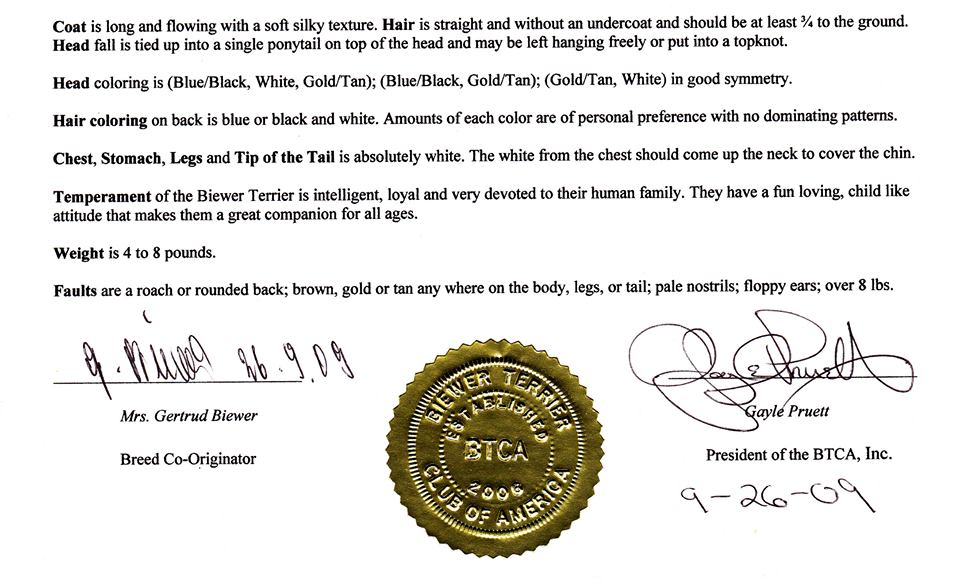
Judging the Biewer Terrier
Judging the Biewer Terrier – Unique Coloring and Breed-Specific Table Exam Protocol
This article is intended to clarify the color requirements stated in the American Kennel Club Breed Standard for the Biewer Terrier, and to help implement a better breed-specific table exam protocol for judges.
The Standard for the Biewer Terrier lists both Blue or Black, and Gold or Tan (with all the various shades of these colors) as being permissible. For ease of readability, I have opted to discuss the Biewer Terrier color by limiting the discussion to BLACK, TAN and WHITE. To be clear: Black isn’t preferred over Blue, and neither is Tan over Gold! In some dogs, the Black changes to Blue, and the Tan turns into a light Gold.
There is a wide array of Tan/Gold and Black/Blue, therefore, the Standard makes allowances for either Black or Blue, and either Tan or Gold. Not all the Black will turn to Blue and some dogs retain very dark Tans. An exhibit may also have Blue and Black as well as the White and Tan, it doesn’t mean the exhibit has four colors. Black and Blue are considered the same color. The same is true for Tan and Gold being a single color, and there are several shades of each.
The head can be Black, Tan and White. However, and this is where it gets more complicated, the head doesn’t necessarily have to have these three colors for the exhibit to be correct. The only requirement is that the exhibit has Tan present in the combination, and that there is some harmony and symmetry in the distribution of the head colors.
The AKC Standard dedicates a full paragraph to Color. It starts with: “The Biewer Terrier is a uniquely colored toy terrier.” Why is the Biewer Terrier so unique? Because it is a tri-colored dog, but unlike other tri-colored breeds, Biewer Terriers are tri-colored only because of the presence of Tan on the head. The body color, in contrast, can only be Black and White and the Standard is very specific with regard to placement. Let’s investigate the color requirements for the Head and the Body per the Breed Standard through a series of illustrations by artist Fan Yu.
Head Color
“Head Coloring—Blue/Black, Gold/Tan and White in good symmetry. Any combination of the following two colors, (Blue/Black and Gold/Tan); (Gold/Tan and White) in good symmetry is acceptable.”
The head can be Black, Tan and White. However, and this is where it gets more complicated, the head doesn’t necessarily have to have these three colors for the exhibit to be correct. The only requirement is that the exhibit has Tan present in the combination, and that there is some harmony and symmetry in the distribution of the head colors. Therefore, the head color can be black and tan, or it can be white and tan. The chin must always be white. There should be no tan anywhere else on the body. The Standard makes an exception for a small amount of tan around the anus as being permissible. A Black and White head is a disqualification
Body Color
“Body Coloring—Hair on back is Blue/Black and White. Amounts of each color are of personal preference with no dominating patterns. No amount of Tan hair may be found on the back, belly, chest, legs or feet. A small amount of Tan hair may be found around the anus. Chest, Stomach, Legs and tip of the Tail—White. The White from the chest should come up the neck to cover the chin. Legs are to be White from the elbows and stifles to the feet.”
To demonstrate a variety of correct body color patterns, please consider the photographs above of Biewer Terrier puppies where the hair is short enough to see acceptable coat patterns clearly.
It is important to clarify two statements about body color.
The first statement: “Amounts of each color are of personal preference with no dominating patterns.” Please consider the photograph of the middle puppy: the body color is acceptable on this puppy only because there is Black on the topline at the base of its tail; without it it would have an all White topline (the Black spots on its body are on the sides and will be covered eventually by the White hair growing from the topline).
An exhibit like the puppy on the right with a mostly Black saddle is acceptable. Some exhibits may even be darker still with less White. Others may be mostly White with a single Black mark, no matter how small that mark may be. It is acceptable to have mostly Black or mostly White bodies as long as both colors are present on the topline. Please note that exhibits with mostly White bodies are more susceptible to Black and Blue ticking. This ticking is acceptable. However, Tan ticking is not acceptable.
Please consider the color illustrations on this page, which demonstrate a random sample of acceptable patterns of body color.
The second statement: “Legs are to be White from the elbows and stifles to the feet.” Please be aware that the elbow joint is higher than the stifle joint. Therefore, the Standard makes allowance for Black on the rear legs to the stifle joint.
The Breed Standard lists the following disqualifications:
“Blue eye(s); Brown or liver pigmentation of the eye rims, nose, lips and pads. Any other color or combination of colors other than those that are listed.” With these in mind, let us discuss the appropriate breed-specific table exam.


